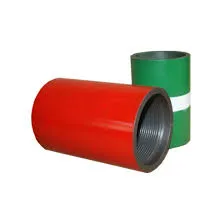Exploring the Benefits and Applications of J55% Coupling in Oil and Gas Industry
Understanding J55 Coupling A Key Component in Oil and Gas Industry
The J55 coupling is an essential component in the oil and gas industry, particularly in the context of drilling and production operations. As a specific type of casing and tubing, J55 is renowned for its mechanical properties, making it an ideal choice for various applications in the extraction of oil and natural gas.
What is J55 Coupling?
J55 is classified as a type of steel grade that meets the specifications of American Petroleum Institute (API) 5CT. It is commonly used for seamless and welded casing and tubing pipes that are instrumental in the exploration and production of oil and gas. The “J” in J55 signifies the grade of steel, while the “55” indicates a minimum yield strength of 55,000 psi (pounds per square inch). This high yield strength is crucial to withstand the significant pressures encountered in subterranean environments.
Mechanical Properties
One of the main advantages of J55 coupling is its exceptional mechanical properties. Apart from its yield strength, J55 steel exhibits good ductility and tensile strength, which are essential for handling the rigors of drilling operations. Its corrosion resistance, especially in various well conditions, makes it a suitable option for many exploration projects where exposure to harsh environments is expected. The combination of these properties ensures that J55 couplings can withstand the mechanical stresses and corrosive elements present in oilfield operations.
Applications
j55 coupling

J55 couplings are predominantly used in the oil and gas industry for well casing, which stabilizes the wellbore during the drilling process. Additionally, it serves as a barrier to prevent the migration of fluids between geological formations. These couplings also play a pivotal role in tubing strings used in the production of hydrocarbons. Their robustness ensures that they not only facilitate the safe transport of oil and gas but also enhance the lifespan of the installations.
In offshore drilling, J55 coupling is employed in riser systems, which connect the drilling rig to the underwater wellhead. The deep-water environments can impose extreme external pressures; hence, using J55 ensures structural integrity and operational safety. The versatility of J55 coupling extends further into the geothermal energy sector, where similar pressures and conditions prevail.
Manufacturing Standards
To ensure the reliability and quality of J55 couplings, strict manufacturing standards are adhered to. The API 5CT specification outlines the requirements for chemical composition, mechanical properties, and manufacturing processes. Rigorous testing and quality control measures are implemented to affirm that the couplings perform optimally under extreme conditions.
Conclusion
In conclusion, the J55 coupling is a fundamental component that underpins the efficiency and safety of oil and gas extraction operations. Its high yield strength, corrosion resistance, and mechanical reliability make it an indispensable choice for casing and tubing applications. As the demand for oil and gas continues to grow, advancements in manufacturing techniques and materials science will likely enhance the capabilities of J55 couplings, ensuring they remain at the forefront of the industry. Understanding the role and specifications of J55 coupling is essential for professionals in the oil and gas sector, as it directly influences both operational success and safety in extracting valuable natural resources from beneath the earth’s surface.
-
Unlock the Benefits of Pup Joints for Your OperationsNewsOct.31,2024
-
The Quality of Casing Couplings from ChinaNewsOct.31,2024
-
The Essential Role of Pup Joints in Drilling OperationsNewsOct.31,2024
-
The Benefits of Tubing Couplings for Your ProjectsNewsOct.31,2024
-
Enhance Your Drilling Operations with Tubing Pup JointsNewsOct.31,2024
-
Elevate Your Drilling Operations with Tubing CrossoversNewsOct.31,2024







